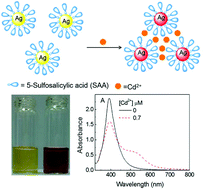Ultrasensitive colorimetric assay of cadmium ion based on silver nanoparticles functionalized with 5-sulfosalicylic acid for wide practical applications†
Abstract
Low-level cadmium ion (Cd2+) exposure contributes much toward the causation of chronic disease. Due to its low permissible exposure limit, overexposures may occur even in situations where trace quantities of Cd2+ exist. So far, no effective treatment for Cd2+ toxicity has been reported. Prevention of further exposure is the most important step in management of patients suggestive of Cd2+ intoxication. Development of sensors for Cd2+ is of great interest to ensure early diagnosis and improve management. We propose here a simple, low-cost (0.1$ per sample) yet very sensitive (limit of detection is 3.0 nM) and selective colorimetric assay for rapid (2 min) determination of Cd2+ based on 5-sulfosalicylic acid functionalized silver nanoparticles (SAA–AgNPs). This method shows excellent selectivity for Cd2+ over the other 16 metal ions. It is also precise and highly reproducible in determining Cd2+ in real samples such as tap water, milk, serum, and urine with recoveries ranging from 93 to 110%, indicating the wide practical application to samples suspected of Cd2+ exposure.


 Please wait while we load your content...
Please wait while we load your content...